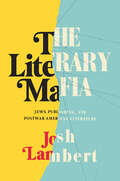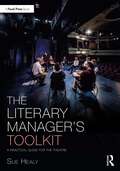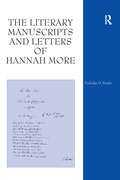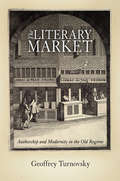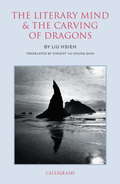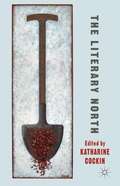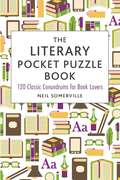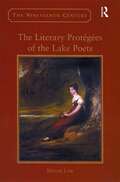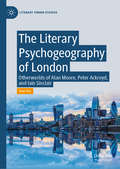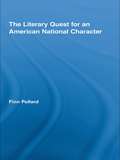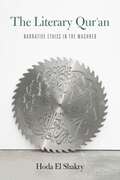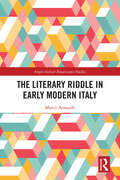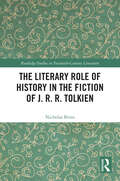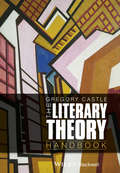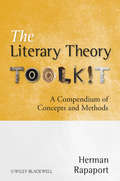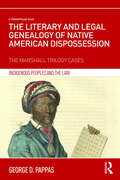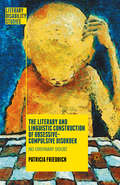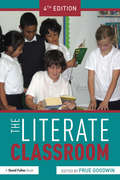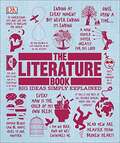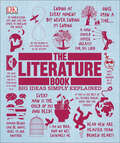- Table View
- List View
The Literary Mafia: Jews, Publishing, and Postwar American Literature
by Josh LambertAn investigation into the transformation of publishing in the United States from a field in which Jews were systematically excluded to one in which they became ubiquitous &“Readers with an interest in the industry will find plenty of insights.&”—Publishers Weekly &“From the very first page, this book is funnier and more gripping than a book on publishing has any right to be. Anyone interested in America&’s intellectual or Jewish history must read this, and anyone looking for an engrossing story should.&”—Emily Tamkin, author of Bad Jews In the 1960s and 1970s, complaints about a &“Jewish literary mafia&” were everywhere. Although a conspiracy of Jews colluding to control publishing in the United States never actually existed, such accusations reflected a genuine transformation from an industry notorious for excluding Jews to one in which they arguably had become the most influential figures. Josh Lambert examines the dynamics between Jewish editors and Jewish writers; how Jewish women exposed the misogyny they faced from publishers; and how children of literary parents have struggled with and benefited from their inheritances. Drawing on interviews and tens of thousands of pages of letters and manuscripts, The Literary Mafia offers striking new discoveries about celebrated figures such as Lionel Trilling and Gordon Lish, and neglected fiction by writers including Ivan Gold, Ann Birstein, and Trudy Gertler. In the end, we learn how the success of one minority group has lessons for all who would like to see American literature become more equitable.
The Literary Manager's Toolkit: A Practical Guide for the Theatre (The Focal Press Toolkit Series)
by Sue HealyThe Literary Manager’s Toolkit is a clear and comprehensive guide to the role of the literary manager in theatre and beyond, focusing on the key skills, networks, and processes that underpin a successful career in this and associated roles. This book outlines the tasks and responsibilities of a literary manager in the selection, development, and production of new plays. In the first part, it outlines the how, when, and why of the literary manager’s main activities, equipping the reader with everything that they will need when approaching this role’s central challenges. The second part provides a selection of practical, accessible, and easy-to-follow materials and workshop suggestions for literary managers who will work with playwrights as they develop their creative writing and dramaturgy skills. This is the go-to resource for the working professional literary manager or dramaturg, and for students on dramaturgy courses in theatre degree programmes.
The Literary Manuscripts and Letters of Hannah More
by Nicholas D. SmithThe result of extensive archival investigation, this meticulously researched book collects and describes for the first time the extant literary manuscripts and letters of the celebrated Bluestocking writer and Evangelical philanthropist Hannah More (1745-1833). Participating in the ongoing recovery of eighteenth-century women writers, Nicholas D. Smith's survey is an indispensable reference work not only for More scholars but for those researching the careers of many of her contemporaries. Features include an extended narrative analysis of the manuscripts that plots More's participation in the manuscript culture of the period and contextualizes the individual entries in the index; provenance details for the more substantial manuscript holdings in British and North American repositories; and identification of numerous autograph manuscripts and transcripts in public and private collections. More than 1,500 letters in 95 locations in Britain and North America have been inventoried and precise dates and internal locators are supplied when known. More's letters, the majority of which have never been published, are a largely untapped source of primary materials for scholars and students researching such diverse subjects as the literary activities and opinions of the Bluestocking circle, women's conduct and education, publishing and the book trade, the national debate over the abolition of the slave trade, the rise of the Evangelical movement, the conservative reaction to the American and French revolutions, and the Napoleonic wars.
The Literary Market: Authorship and Modernity in the Old Regime (Material Texts)
by Geoffrey TurnovskyA central theme in the history of Old Regime authorship highlights the opportunities offered by a growing book trade to writers seeking to free themselves from patrons and live "by the pen." Accounts of this passage from patronage to market have explored in far greater detail the opportunities themselves—the rising sums paid by publishers and the progression of laws protecting literary property—than how and why writers would have seized on them, no doubt because the choice to do so has seemed an obvious or natural one for writers assumed to prefer economic self-sufficiency over elite protection.In The Literary Market, Geoffrey Turnovsky claims that there was nothing obvious or natural about the choice. Writers had been involved in commercial book publication since the earliest days of the printing press, yet had not necessarily linked these activities with their freedom to think and write. The association of autonomy and professionalism was forged, not given. Analyzing the literary market as a key articulation of the association, Turnovsky explores how in eighteenth-century polemics a rhetoric of commercial authorship came to signify independence for intellectuals. He finds the roots of the connection not in the claims of entrepreneurial writers to rights and income but in a world to which that of the modern author has been contrasted: the aristocratic culture of the seventeenth century. Aristocratic culture, he argues, generated a disparaging view of the professional author as one defined by activities tainting him or her as greedy and arrogant and therefore unworthy of protection and socially isolated. The Literary Market examines the story of the "birth of the author" in terms of the revalorization of this negative trope in Enlightenment-era debates about the radically changing role of writers in society.
The Literary Mind and the Carving of Dragons
by Liu Hsieh Vincent Yu-chung ShihThe Literary Mind and the Carving of Dragons is the first comprehensive work of literary criticism in Chinese, and one that has been considered essential reading for writers and scholars since it was written some 1,500 years ago. A vast compendium of all that was known about Chinese literature at the time, it is simultaneously a taxonomy and history of genres and styles and a manual for good writing. Its chapters, organized according to the I Ching, cover such topics as "Choice of Style," "Emotion and Literary Expression," "Humor and Enigma," "Spiritual Thought or Imagination," "The Nourishing of Vitality," and "Literary Flaws.""Mind" is the ideas, impressions, and emotions that take form--the "carving of the dragon"--in a literary work. Full of examples and delightful anecdotes drawn from Liu Hsieh's encyclopedic knowledge of Chinese literature, readers will discover distinctive concepts and standards of the art of writing that are both alien and familiar. The Literary Mind and the Carving of Dragons is not only a summa of classical Chinese literary aesthetics but also a wellspring of advice from the distant past on how to write.
The Literary North
by Katharine CockinAccording to George Orwell, the North was 'a strange country'. In a grim, industrial landscape, its working-class inhabitants seem to inhabit a bleak world permanently caught in the piercing gaze of 1930s realism. Stereotypes of the North have been tenacious. This book challenges and analyzes the force of these stereotypes, establishing the strategic and mobile nature of 'the North' and the longlasting effects of literary realism. This reassessment is introduced by Josephine Guy's analysis of the nineteenth-century industrial context and pursues a chronological journey through the worlds of children's literature, George Moore, Arnold Bennett, Ewan MacColl, the Northern local press, W. H. Auden, Alan Sillitoe, Richard Hoggart, Keith Waterhouse, Tony Harrison, Andrea Dunbar, Jim Cartwright, the AHRC Moving Manchester project and Northern cyberpunk. Sean O'Brien takes us to 'The Unknown City: Hull and the North in the poetry of Larkin, Dunn and Disbury'. Join us on this journey to defamiliarize and revitalize the Literary North.
The Literary Pocket Puzzle Book: 120 Classic Conundrums for Book Lovers
by Neil SomervilleAre you bursting with literary knowledge that you’d like to put to the test? Or do you just want a moment’s distraction filling in a Harry Potter- or Lord of the Rings-themed crossword puzzle, looking up the names of Charles dinkens’s characters in a word search, or completing a Jane Austen sudoku puzzle?The Literary Pocket Puzzle Book offers puzzles of varying difficulty levels and literary themes that will amuse, excite, and inform. This handy, portable pocket-sized book features 120 craft conundrums that will keep you scratching your head over famous author pen names and obscure literary terms as you exercise your knowledge on Shakespeare, Mark Twain, Marcel Proust, Henry James, and James Joyce. For all book-loving puzzle solvers or puzzle-loving book readers, The Literary Pocket Puzzle Book is the perfect avenue to unwind, or be challenged.
The Literary Protégées of the Lake Poets (The Nineteenth Century Series)
by Dennis LowDennis Low's re-evaluation of the Lake Poets as mentors begins with the controversial premise that Robert Southey was one of the nineteenth-century's greatest champions of women's writing. Together with Wordsworth and Coleridge, Low argues, Southey tried to end what he perceived to be the cultural decline of literature by nurturing the creative talents of many exceptional women writers. Drawing on 3,000 unpublished manuscripts in England, Scotland and the United States, Low examines the lives and works of four of the Lake Poets' literary protégées: Caroline Bowles, Maria Gowen Brooks, Sara Coleridge and Maria Jane Jewsbury. Though diverse in terms of their literary production, these women were united in their defiant efforts to write against an increasingly stagnant cultural milieu and their negotiation, wholeheartedly encouraged by their mentors, of contemporary publishing mores. This scrupulously researched book is a valuable contribution to the study of little-known women writers and to our understanding of the literary and publishing environment of Britain in the 1820s and 1830s.
The Literary Psychogeography of London: Otherworlds of Alan Moore, Peter Ackroyd, and Iain Sinclair (Literary Urban Studies)
by Ann TsoThis Pivot book examines literary elements of urban topography that have animated Alan Moore, Peter Ackroyd, and Iain Sinclair’s respective representations of London-ness. Ann Tso argues these authors write London “psychogeographically” to deconstruct popular visions of London with colonial and neoliberal undertones. Moore’s psychogeography consists of bird’s-eye views that reveal the brute force threatening to unravel Londonscape from within; Ackroyd’s aims to detect London sensuously, since every new awareness recalls an otherworldly London; Sinclair’s conjures up a narrative consciousness made erratic by London’s disunified landscape. Drawing together the dystopian, the phenomenological, and the postcolonial, Tso explores how these texts characterize “London-ness” as estranging.
The Literary Quest for an American National Character (Routledge Transnational Perspectives on American Literature)
by Finn Pollard"What then is the American, this new man?" This question is explored here through the lives and writings of a sequence of imaginative authors each of whom confronted a crucial moment in the evolution of the new nation (from Crevecoeur and the Revolution, through Washington Irving and Jeffersonian Democracy, to James Fenimore Cooper and the Era of Good Feelings). At the centre of these confrontations was a division between those who claimed national perfection had been obtained, and those who, while desperately wanting to believe this, perceived all too clearly that that perfection had not yet come. Rediscovering this neglected literary debate, The Literary Quest for an American National Character illuminates afresh the traumatic birth and development of the new American nation.
The Literary Qur'an: Narrative Ethics in the Maghreb
by Hoda El ShakryWinner, 2020 Aldo and Jeanne Scaglione Prize for Comparative Literary Studies, Modern Language AssociationThe novel, the literary adage has it, reflects a world abandoned by God. Yet the possibilities of novelistic form and literary exegesis exceed the secularizing tendencies of contemporary literary criticism. Showing how the Qurʾan itself invites and enacts critical reading, Hoda El Shakry’s Qurʾanic model of narratology enriches our understanding of literary sensibilities and practices in the Maghreb across Arabophone and Francophone traditions. The Literary Qurʾan mobilizes the Qurʾan’s formal, narrative, and rhetorical qualities, alongside embodied and hermeneutical forms of Qurʾanic pedagogy, to theorize modern Maghrebi literature. Challenging the canonization of secular modes of reading that occlude religious epistemes, practices, and intertexts, it attends to literature as a site where the process of entextualization obscures ethical imperatives. Engaging with the Arab-Islamic tradition of adab—a concept demarcating the genre of belles lettres, as well as social and moral comportment—El Shakry demonstrates how the critical pursuit of knowledge is inseparable from the spiritual cultivation of the self.Foregrounding form and praxis alike, The Literary Qurʾan stages a series of pairings that invite paratactic readings across texts, languages, and literary canons. The book places twentieth-century novels by canonical Francophone writers (Abdelwahab Meddeb, Assia Djebar, Driss Chraïbi) into conversation with lesser-known Arabophone ones (Maḥmūd al-Masʿadī, al-Ṭāhir Waṭṭār, Muḥammad Barrāda). Theorizing the Qurʾan as a literary object, process, and model, this interdisciplinary study blends literary and theological methodologies, conceptual vocabularies, and reading practices.
The Literary Riddle in Early Modern Italy (Anglo-Italian Renaissance Studies)
by Marco ArnaudoThis book describes the development of the literary riddle in Renaissance Italy, when poets appropriated riddles from oral tradition, combined them with the conventions of literature, and paired them with solutions that could be checked after reading. This book includes an original theoretical framework for the investigation of riddles, dividing riddles into categories based on their enigmatic link. A section about the social uses of riddles in early modern Italy shows how riddles were routinely exchanged at soirees and in the activities of academies and congreghe, all environments where the folk qualities of the riddle could be playfully appreciated. The riddle became a key element in narrative works by Giovanni Francesco Straparola and Ascanio de’ Mori, and, for the first time, it fueled enough collections of poems to trigger an entire genre. Examples will come from Angelo Cenni, Daphne di Piazza, Girolamo Musici, Tommaso Stigliani, Giulio Cesare Croce, Antonio Malatesti, and many others.
The Literary Role of History in the Fiction of J. R. R. Tolkien (Routledge Studies in Twentieth-Century Literature)
by Nicholas BirnsThis volume analyzes the literary role played by history in the works of J. R. R. Tolkien. It argues that the events of The Lord of the Rings are placed against the background of an already-existing history, both in reality and in the fictional worlds of the books. History is unfolded in various ways, both in explicitly archival annals and in stories told by characters on the road or on the fly, and in which different visions of history emerge. In addition, the history within the work can resemble, or be patterned on, histories in our world. These histories range from the deep past of prehistoric and ancient worlds to the early medieval era of the barbarian invasions and Byzantium, to the modern worlds of urbane civility and a paradoxical longing for nature, and finally to great power rivalries and global prospects. The book argues that Tolkien did not employ these histories indiscriminately or reductively. Rather, he regarded them as aspects of aesthetic and representative figuration that are above all literary. While most criticism has concentrated on Tolkien’s use of historical traditions of Northern Europe, this book argues that Tolkien also valued Southern and Mediterranean pasts and registered the Germanic and the Scandinavian pasts as they related to other histories as much as his vision of them included a primeval mythic aura.
The Literary Theory Handbook
by Gregory CastleThe Literary Theory Handbook introduces students to the history and scope of literary theory, showing them how to perform literary analysis, and providing a greater understanding of the historical contexts for different theories. A new edition of this highly successful text, which includes updated and refined chapters, and new sections on contemporary theories Far reaching in its inclusion of a detailed history of theory and in-depth discussions of major theories and movements Four distinct perspectives on theory--historical, thematic, biographical, practical--are carefully intertwined, so that key concepts, terms and ideas are developed in different contexts and cross-referenced, in the text and in the index. Includes alphabetically-arranged biographies designed for quick reference, and sample readings to illustrate the practical application of theory
The Literary Theory Toolkit
by Herman RapaportThe Literary Theory Toolkit offers readers a rich compendium of key terms, concepts, and arguments necessary for the study of literature in a critical-theoretical context. Includes varied examples drawn from readily available literary texts spanning all periods and genres Features a chapter on performance, something not usually covered in similar texts Covers differing theories of the public sphere, ideology, power, and the social relations necessary for the understanding of approaches to literature
The Literary and Legal Genealogy of Native American Dispossession: The Marshall Trilogy Cases (Indigenous Peoples and the Law)
by George D PappasThe Literary and Legal Genealogy of Native American Dispossession offers a unique interpretation of how literary and public discourses influenced three U.S. Supreme Court Rulings written by Chief Justice John Marshall with respect to Native Americans. These cases, Johnson v. M’Intosh (1823), Cherokee Nation v. Georgia (1831) and Worcester v. Georgia (1832), collectively known as the Marshall Trilogy, have formed the legal basis for the dispossession of indigenous populations throughout the Commonwealth. The Trilogy cases are usually approached as ‘pure’ legal judgments. This book maintains, however, that it was the literary and public discourses from the early sixteenth through to the early nineteenth centuries that established a discursive tradition which, in part, transformed the American Indians from owners to ‘mere occupants’ of their land. Exploring the literary genesis of Marshall’s judgments, George Pappas draws on the work of Michel Foucault, Edward Said and Homi Bhabha, to analyse how these formative U.S. Supreme Court rulings blurred the distinction between literature and law.
The Literary and Linguistic Construction of Obsessive-Compulsive Disorder: No Ordinary Doubt (Literary Disability Studies)
by Patricia FriedrichThis book presents a literary and linguistic reading of obsessive-compulsive disorder to argue that medical understandings of disability need their social, political, literary and linguistic counterparts, especially if we aspire to create a more inclusive, self-reflective society.
The Literate Classroom
by Prue GoodwinNow in its fourth edition, The Literate Classroom combines a range of refreshing and challenging viewpoints from experienced classroom practitioners in order to offer practical and effective approaches to teaching reading and writing to primary students. Over the last few years, how teachers talk with children about their learning has been missing from much of the documentation going into school, but with essential information and advice, this book highlights the importance of speaking and listening in literacy learning and recognises the powerful links between reading, writing and dialogic talk. This fully updated edition includes: shared and guided reading and writing comprehension through response to children’s literature guidance on literacy teaching with ELL pupils new chapters on digital literacy, drama for literacy, talk for spelling and poetry. The Literate Classroom describes how the theory behind key areas of literacy teaching can be transformed into realistic learning experiences within the classroom. An accessible and informative collection, this book is a must-have for any teachers of literacy in the primary sector.
The Literature Book: Big Ideas Simply Explained (Big Ideas)
by DkStorytelling is as old as humanity itself. Part of the Big Ideas Simply Explained series, The Literature Book introduces you to ancient classics from the Epic of Gilgamesh written 4,000 years ago, as well as the works of Shakespeare, Voltaire, Tolstoy, and more, and 20th-century masterpieces, including Catch-22, Beloved, and On the Road. The perfect reference for your bookshelf, it answers myriad questions such as what is stream of consciousness, who wrote To Kill a Mockingbird, and what links the poetry of Wordsworth with that of TS Eliot. <p><p> Losing yourself in a great book transports you to another time and place, and The Literature Book sets each title in its social and political context. It helps you appreciate, for example, how Dickens’ Bleak House paints a picture of deprivation in 19th-century England, or how Stalin’s climb to power was the backdrop for George Orwell’s 1984. <p><p> With succinct plot summaries, graphics, and inspiring quotations, this is a must-have reference for literature students and the perfect gift for book-lovers everywhere. <p><p> Series Overview: Big Ideas Simply Explained series uses creative design and innovative graphics along with straightforward and engaging writing to make complex subjects easier to understand. With over 7 million copies worldwide sold to date, these award-winning books provide just the information needed for students, families, or anyone interested in concise, thought-provoking refreshers on a single subject.
The Literature Book: Big Ideas Simply Explained (DK Big Ideas)
by DKLearn about the greatest works of literature, and the lives of those who wrote them in The Literature Book.Part of the fascinating Big Ideas series, this book tackles tricky topics and themes in a simple and easy to follow format. Learn about Literature in this overview guide to the subject, great for beginners looking to learn and experts wishing to refresh their knowledge alike! The Literature Book brings a fresh and vibrant take on the topic through eye-catching graphics and diagrams to immerse yourself in. This captivating book will broaden your understanding of Literature, with:- More than 100 ground-breaking ideas on major literary works- Packed with facts, charts, timelines and graphs to help explain core concepts- A visual approach to big subjects with striking illustrations and graphics throughout- Easy to follow text makes topics accessible for people at any level of understandingThe Literature Book is the perfect introduction to masterpieces from the world&’s greatest authors, aimed at adults with an interest in the subject, and literature students wanting to gain more of an overview. Here you&’ll discover more than 100 articles exploring landmark novels, short stories, plays, and poetry that reinvented the art of writing in their time.Your Literature Questions, Simply ExplainedFrom the Iliad to The Great Gatsby, embark on a fascinating, graphic-led journey through the greatest works of poetry and prose. If you thought it was difficult to learn about the fictional masterpieces of our time and the literary geniuses behind them, The Literature Book presents key information in an easy to follow layout. From Modernism to Shakespearean, Realism to Romanticism, discover the literary movements through fantastic mind maps and step-by-step summaries.The Big Ideas SeriesWith millions of copies sold worldwide, The Literature Book is part of the award-winning Big Ideas series from DK. The series uses striking graphics along with engaging writing, making big topics easy to understand.
The Literature Review: A Step-By-Step Guide for Students
by Diana RidleyThis Second Edition of Diana Ridley's bestselling guide to the literature review outlines practical strategies for reading and note taking, and guides the reader on how to conduct a systematic search of the available literature, and uses cases and examples throughout to demonstrate best practice in writing and presenting the review. New to this edition are examples drawn from a wide range of disciplines, a new chapter on conducting a systematic review, increased coverage of issues of evaluating quality and conducting reviews using online sources and online literature and enhanced guidance in dealing with copyright and permissions issues.
The Literature Workbook
by Clara Calvo Jean Jacques WeberThe Literature Workbook is a practical introductory textbook for literary studies, which can be used either for independent study or as part of a taught class. Laying the ground for further study, The Literature Workbook introduces the beginning student to the essential analytic and interpretative skills that are needed for literary appreciation and evaluation. It also equips the teacher with practical tools and materials for use in seminars or when setting written assessments and projects. Arranged according to genre and chronology, the chapters acquaint the reader with a range of key figures in English literaure and encourage the reader to think about them in their historical and cultural contexts. Adopting a user-friendly case-study approach, each chapter contains * exercises and activities * discussion hints * project work * suggestions for further reading The Workbook also includes: * a glossary * a subject and name index.
The Literature and Arts of the Niger Delta (Routledge Contemporary Africa)
by Tanure Ojaide Enajite Eseoghene OjaruegaThis book examines the depiction of the Delta region of Nigeria through literature and other cultural art forms. The Niger Delta has been thrust into the global limelight due to resource extraction and conflict, but it is also a region with a rich culture, environment, and heritage. The creative imagination of the area’s artists has been fuelled by the area’s pressing concerns of indigenous peoples, minority discourse, environmental degradation, climate change, multinational corporations' greed, dictatorship, and people’s struggle for control of their resources. Taking a holistic approach to the Niger Delta experience, this book showcases artistic responses from literature, visual arts, and performances (such as masquerades, dances, and festivals). Chapters cover authors, artists, and performers such as Ben Okri, Ken Saro-Wiwa, Isidore Okpewho, J.P. Clark, and Bruce Onobrakpeya, as well as topics like the famous Benin bronze figures and Urhobo Udje dance. Affirming the wealth and diversity of the region which continues to inspire creative artistic productions, The Literature and Arts of the Niger Delta will be of interest to researchers of African literature, arts, and other cultural productions.
The Literature and Cultural Ecology of Imperial Examinations in the Ming Dynasty
by Wenxin ChenThe book examines the relationship between imperial examinations and literature from the perspective of restoring the cultural ecology of imperial examinations in Ming China, breaking through the paradigm of pure literature research. This book presents an important practice in adjusting the pattern of literary research. The contents of this book include five mutually independent but supportive parts: 1) the living conditions and careers of the literary attendants; 2) the educational background and school’s consciousness of the Ming literati; 3) top candidates and Ming literature; 4) genres of imperial examination and the Ming society; 5) exam cheating cases from the perspective of politics and literature. This book will appeal to readers interested in Chinese literature and culture and the imperial examination system in ancient China.
The Literature of Absolute War: Transnationalism and World War II
by Nil SantiáñezThis book explores for the first time the literature of absolute war in connection to World War II. From a transnational and comparative standpoint, it addresses a set of theoretical, historical, and literary questions, shedding new light on the nature of absolute war, the literature on the world war of 1939–45, and modern war writing in general. It determines the main features of the language of absolute war, and how it gravitates around fundamental semantic clusters, such as the horror, terror, and the specter. The Literature of Absolute War studies the variegated responses given by literary authors to the extreme and seemingly unsolvable challenges posed by absolute war to epistemology, ethics, and language. It also delves into the different poetics that articulate the writing on absolute war, placing special emphasis on four literary practices: traditional realism, traumatic realism, the fantastic, and catastrophic modernism.
